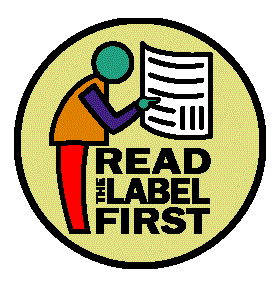Compatibility Test for Pesticide Mixtures
 Please read the pesticide label prior to use. The information contained at this web
site is not a substitute for a pesticide label. Trade names used herein are for convenience
only. No endorsement of products is intended, nor is criticism of unnamed products
implied.
Please read the pesticide label prior to use. The information contained at this web
site is not a substitute for a pesticide label. Trade names used herein are for convenience
only. No endorsement of products is intended, nor is criticism of unnamed products
implied.
Warning: Always wear personal protective equipment (PPE) when pouring or mixing pesticides.
Pesticides used in this test should be put into the spray tank when completed. Rinse all utensils and jars and pour the rinse water (rinsate) into the spray tank. Do not use utensils or jars for any other purpose after they have contacted pesticides.
- Measure one pint of spray water (or other diluent) that you will use when making up the larger mixture into a clear quart glass jar.
- Adjust the pH, if necessary, with a buffer or acidifier.
- Add pesticides to the diluent using the "D-A-L-E-S" plan.
- Dry flowable and wettable powders formulations: add 1 tablespoon for each pound per 100 gallons of planned final spray mixture.
- Agitate thoroughly.
- Liquid products such as water soluble concentrates or solutions: add 1 teaspoon for each pint per 100 gallons of planned final spray mixture.
- Emulsifiable concentrate and flowable formulations: add 1 teaspoon for each pint per 100 gallons of planned final spray mixture.
- Surfactants, compatibility agents, and activators; add 1 teaspoon for each pint per 100 gallons of planned final spray mixture.
- After mixing, let the solution stand for 15 minutes. Stir well and observe the results.
Compatability
Chemicals can be used together in the spray tank:
- Smooth mixture
- Combines well after stirring
Incompatible
Do not mix this combination in the spray tank:
- Separation Clumps
- Grainy appearance
- Settles out quickly after stirring
Resolving Incompatibility
- If the mixture is still incompatible, do not mix the chemicals in the spray tank. To overcome this problem you might consider the following alternatives:
- If incompatibility still persists, dispose of this mixture, clean the jar, and repeat the above steps, but add 6 drops of compatibility agent to the water before anything else is added.
- Add 6 drops of compatibility agent and stir well. If mixture appears compatible, allow
it to stand for 1 hour, stir well, and check it again. If the mixture appears incompatible,
repeat one or two more times, using 6 drops of compatibility agent each time.
- Use a different water supply. Hard water can contribute to incompatibility.
- Change brands or formulations of chemicals
- Change the order of mixing.
- Make only one chant at a time, and perform a complete test, as described above, before making another change. Do not mix the chemicals in the spray tank if incompatibility cannot be resolved.
Updated on: 01/02/08.
